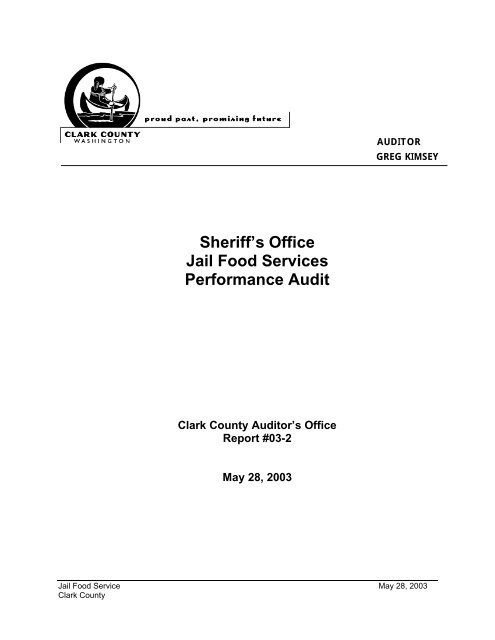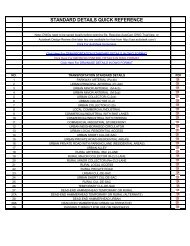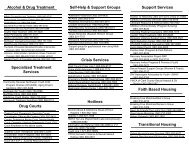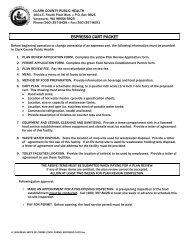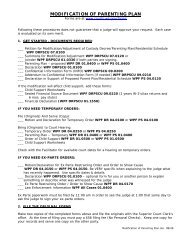Clark County Jail Food Services Performance Audit Report
Clark County Jail Food Services Performance Audit Report
Clark County Jail Food Services Performance Audit Report
Create successful ePaper yourself
Turn your PDF publications into a flip-book with our unique Google optimized e-Paper software.
AUDITOR<br />
GREG KIMSEY<br />
Sheriff’s Office<br />
<strong>Jail</strong> <strong>Food</strong> <strong>Services</strong><br />
<strong>Performance</strong> <strong>Audit</strong><br />
<strong>Clark</strong> <strong>County</strong> <strong>Audit</strong>or’s Office<br />
<strong>Report</strong> #03-2<br />
May 28, 2003<br />
<strong>Jail</strong> <strong>Food</strong> Service May 28, 2003<br />
<strong>Clark</strong> <strong>County</strong>
<strong>Clark</strong> <strong>County</strong> Internal <strong>Audit</strong> Department<br />
Sheriff’s Office <strong>Jail</strong> <strong>Food</strong> <strong>Services</strong> <strong>Performance</strong> <strong>Audit</strong><br />
TABLE OF CONTENTS<br />
EXECUTIVE SUMMARY.................................................................................................3<br />
OBJECTIVES, SCOPE, AND METHODOLOGY.......................................................................3<br />
SUMMARY OF FINDINGS AND RECOMMENDATIONS .............................................................3<br />
COMMENDATION.............................................................................................................3<br />
BACKGROUND ON JAIL FOOD SERVICE OPERATIONS...........................................4<br />
SUMMARY OF OTHER INSPECTIONS, REVIEWS, AND CERTIFICATIONS ...................................4<br />
MENUS AND PLANNING....................................................................................................4<br />
INVENTORY ORDERS AND CONTROLS...............................................................................5<br />
PREPARATION ................................................................................................................5<br />
DISTRIBUTION ................................................................................................................6<br />
ANSWERS TO THE AUDIT OBJECTIVES.....................................................................7<br />
WHAT FOOD SERVICES ARE PROVIDED AND TO WHOM ......................................................7<br />
WHAT TYPES OF CONTRACTUAL AGREEMENTS ARE IN PLACE FOR THE PROVISION OF<br />
SERVICES.....................................................................................................................7<br />
WHAT ARE THE COSTS ASSOCIATED WITH THE PROVISION OF FOOD SERVICES AND IS THERE<br />
ADDITIONAL CAPACITY ...................................................................................................8<br />
HOW DO WE COMPARE TO OTHER JURISDICTIONS AND CAN WE MAKE ANY IMPROVEMENTS ..9<br />
CAN WE DO ANYTHING TO REDUCE INJURIES..................................................................12<br />
DEPARTMENTAL COMMENTS..........................................................................................13<br />
OBJECTIVES, SCOPE AND METHODOLOGY ............................................................ A<br />
OTHER REVIEWS AND INSPECTIONS........................................................................ B<br />
INMATE SURVEY .......................................................................................................... C<br />
MANAGEMENT RESPONSE......................................................................................... D<br />
<strong>Jail</strong> <strong>Food</strong> Service Page 2 May 28, 2003<br />
<strong>Clark</strong> <strong>County</strong>
EXECUTIVE SUMMARY<br />
We have completed an audit of the <strong>Clark</strong> <strong>County</strong> Sheriff’s Office <strong>Jail</strong> <strong>Food</strong> Service. Our<br />
audit, performed in accordance with generally accepted government audit standards, is<br />
intended only to conclude on the stated objectives of this audit. Our review differs from<br />
an examination of financial statements and records for the purpose of expressing an<br />
opinion thereon, and accordingly we do not express such an opinion.<br />
Objectives, Scope, and Methodology<br />
The objectives of this audit work were to determine:<br />
1) What food services are provided and to whom<br />
2) What types of contractual agreements are in place for the provision of services<br />
3) What are the costs associated with the provision of food services<br />
4) How do we compare to other jurisdictions, and are there areas for improvement<br />
5) Can we reduce injuries<br />
Detailed answers to these questions begin at page 7. In performing this work, we<br />
followed the methodologies detailed in Appendix A.<br />
Summary of Findings and Recommendations<br />
The Answers to the <strong>Audit</strong> Objectives section of this report, starting on page 7, details<br />
our conclusions and recommendations.<br />
We found that the kitchen meets and exceeds health standards. The food service<br />
manager has received good marks from outside parties for the kitchen facility, meal<br />
planning, preparation, and distribution of meals. We have no recommendation to<br />
change menus, ordering, or preparation processes. We do make recommendations to:<br />
formalize agreements with other departments, revisit the costing methodology, formalize<br />
periodic reporting from the food service manager to senior management, and use the<br />
opportunity to educate inmates on nutrition.<br />
Commendation<br />
We would like to thank the many staff members from the Sheriff’s Office who<br />
cooperated in and assisted with this audit. Specifically, food service manager <strong>Clark</strong><br />
Campbell and his staff were always available and were very open in discussing the<br />
operations of the kitchen. All managers were responsive during the course of the audit<br />
and endeavored to resolve any issues as they were raised.<br />
<strong>Jail</strong> <strong>Food</strong> Service Page 3 May 28, 2003<br />
<strong>Clark</strong> <strong>County</strong>
BACKGROUND ON JAIL FOOD SERVICE OPERATIONS<br />
The new jail work center opened in 2000, moving the kitchen from a smaller space in<br />
the main jail. With the move, the Sheriff’s Office took on responsibility for providing<br />
meals to Juvenile Detention. Nearly 900 inmates at three jail sites are served at each<br />
meal. The 2002 expense for food purchases was $574,000.<br />
Summary of other inspections, reviews, and certifications<br />
The kitchen is reviewed periodically by different agencies for different purposes; we did<br />
not duplicate those efforts. We have summarized the results of those reviews in<br />
Appendix B. Overall, those reviews are favorable and indicate that the jail kitchen has<br />
low risk of spreading food-borne illness. The inspections show that the kitchen passed<br />
health inspections from the <strong>Clark</strong> <strong>County</strong> Health Department (formerly the Southwest<br />
Washington Health District). In addition, the staff and/or the facility hold these<br />
certifications:<br />
• The food service manager is a Registered Dietician.<br />
• All food service staff 1 hold a county food handler permit.<br />
• The facility holds a National Restaurant Association HACCP certificate (Hazard<br />
Assessment on Critical Control Points) and ServSafe certificate.<br />
Menus and Planning<br />
The kitchen uses a four-week cycle menu. As described on page 7, “What food<br />
services are provided,” individual meals are adjusted for medical or religious<br />
requirements. The meals for Juvenile also meet USDA requirements such as milk with<br />
every meal and a slightly higher caloric intake for juvenile detainees.<br />
Breakfast, clockwise from upper left:<br />
milk, spice cake, hard-boiled egg/salt,<br />
cereal/sugar, banana<br />
Lunch: baked beans, lettuce, instant drink<br />
packet, cheeseburger/mayonnaise<br />
/ketchup, chips<br />
1 “<strong>Food</strong> service staff” are non-inmates<br />
<strong>Jail</strong> <strong>Food</strong> Service Page 4 May 28, 2003<br />
<strong>Clark</strong> <strong>County</strong>
Comparison of <strong>Clark</strong> <strong>County</strong>’s meal planning to other organizations can be found on<br />
page 9, “How do we compare to other jurisdictions and can we make any<br />
improvements”<br />
Inventory Orders and Controls<br />
Grocery-type purchases are regularly put out to bid. Sysco currently supplies the major<br />
weekly food order. Other suppliers are used for orders of bread products, eggs, and<br />
milk.<br />
Controls over inventory include locked doors, cameras, two-person receipting and<br />
verification of incoming orders, logs of food stock used, and weekly physical counts of<br />
food stock. The food is in one of three locked areas: pantry, walk-in refrigerator, or<br />
walk-in freezer. The facility is professionally inspected for signs of pests or vermin, and<br />
treated as needed.<br />
<strong>Food</strong> stock is also controlled for freshness. The kitchen holds about a two-week supply<br />
of stock on hand, and staff rotate stock to be used on a first-in, first-out basis.<br />
Organization and cleanliness: part of the pantry<br />
Locked access to the freezer<br />
We conducted a risk assessment focusing on possible inventory losses. The risks<br />
assessed included low turnover (spoilage from age), theft by inmates, theft by staff,<br />
shortage by supplier, overpreparation (waste), and vermin/other spoilage. We<br />
concluded that the overall risks were mitigated by existing preventive and detective<br />
controls. We did recommend, and the jail work center has implemented, that the food<br />
service manager receive a report anytime the kitchen is entered during off-hours.<br />
Preparation<br />
Two overlapping shifts prepare meals. Training inmates is an important part of the food<br />
service program, and starts with a strict emphasis on handwashing. Working on the<br />
assembly line does not require special training, as the main activity is portioning food<br />
<strong>Jail</strong> <strong>Food</strong> Service Page 5 May 28, 2003<br />
<strong>Clark</strong> <strong>County</strong>
onto trays. But inmates do receive training before using cooking equipment, cutlery<br />
(knives are logged in and out and supervised while used), and cleaning (because of the<br />
chemicals involved).<br />
Oven: 11 pans being baked<br />
Kitchen tools at a preparation table<br />
Distribution<br />
<strong>Food</strong> service staff and inmate workers (trustys) deliver meals to the main jail and the<br />
Juvenile Department. Staff on the receiving end told us that the delivery is very reliable,<br />
which is important in managing the jail and detention.<br />
The food carts have a hot side and a cool (ambient) side to maintain proper food<br />
temperatures. One cart is reserved to hold all the special diets (medical and religious<br />
diets), and each of those trays is labeled to ensure delivery to the intended inmate.<br />
At the end of the meal period, trays are reloaded on the carts and returned to the<br />
kitchen. The trays and carts are cleaned and sanitized.<br />
Loading food carts<br />
Securing food carts in the delivery truck<br />
<strong>Jail</strong> <strong>Food</strong> Service Page 6 May 28, 2003<br />
<strong>Clark</strong> <strong>County</strong>
ANSWERS TO THE AUDIT OBJECTIVES<br />
What food services are provided and to whom<br />
About 900 jail inmates and Juvenile detainees are served at each meal. Within<br />
this population, many have special medical needs for modified diets (25 on the day we<br />
observed details on special meals). <strong>Food</strong> service staff work closely with the Medical<br />
Unit to ensure meals support the medical plan (e.g., low sodium) and do not create<br />
medical problems (e.g., food allergies). By law, jails must also adjust meals for<br />
recognized religious restrictions. The food service at <strong>Clark</strong> <strong>County</strong> jail follows<br />
guidelines set by the Washington Department of Corrections.<br />
<strong>Jail</strong> food service staff are also responsible for maintaining emergency food<br />
service plans, including nutrition bars and water stocked at the main jail. These stocks<br />
would be used if there were a major problem at the kitchen, or with transportation, or a<br />
complete lockdown at the main jail, or any other disruption where normal food service<br />
could not be provided. We confirmed that there is a three-day supply of emergency<br />
rations available at the jail. During our review, we raised questions about the<br />
emergency food stock; these questions were answered, and the Sheriff’s Office clarified<br />
instructions to all custody sergeants.<br />
Finally, a new service from the jail kitchen provides sack lunches to a school<br />
district General Educational Development (GED) program. Low-income students qualify<br />
for the USDA school lunch program, and the Vancouver School District will order<br />
lunches from the Sheriff’s Office. In turn, the Sheriff’s Office will be reimbursed $2.09<br />
per meal from the USDA program. This is the standard federal reimbursement and will<br />
cover the direct $1.62 cost (food and labor) plus contribute towards overhead costs.<br />
(Costs are discussed starting on the next page.)<br />
What types of contractual agreements are in place for the provision of services<br />
In 2000, food service for the Juvenile detainees was taken over by the Sheriff’s Office.<br />
At the time, there were no formal agreements for the transfer of these services between<br />
departments; a Memorandum of Understanding (MOU) was completed during our audit.<br />
Since about February 2002, sack lunches have also been provided by the Sheriff’s<br />
Office for a GED program operated by Juvenile for non-detainees (separate from the<br />
school district GED program mentioned above). However, there is no written<br />
agreement between the two departments to address cost reimbursements or other<br />
details related to the program. The MOU for regular detainee meals states,<br />
“Compensation/Reimbursement for [GED sack lunches] will be treated as an addendum<br />
to this MOU,” but an addendum has not been completed.<br />
There has been much discussion, without resolution, around whether Juvenile should<br />
be required to pay the Sheriff’s Office for the provision of sack lunches to non-detainees<br />
<strong>Jail</strong> <strong>Food</strong> Service Page 7 May 28, 2003<br />
<strong>Clark</strong> <strong>County</strong>
in the GED program 2 . This unanswered question leaves the Sheriff’s Office supporting<br />
the Juvenile GED program by about $1,000 per quarter. Once a written agreement is<br />
established, there will be no questions about each party’s responsibilities. We<br />
recommend an agreement be completed. Additionally, the Sheriff’s Office should<br />
ensure that written agreements are in place as any substantial changes are made to<br />
existing relationships or for new arrangements with other entities.<br />
What are the costs associated with the provision of food services and is there<br />
additional capacity<br />
Capacity: Management was interested in the capacity of the operation, to know any<br />
limitations on taking advantage of other opportunities, such as supplying the GED<br />
lunches. We were told that the new kitchen was designed to produce up to 1,200<br />
meals, and that the first limitation the kitchen would face would be running out of room<br />
for the finished meals. We agree the kitchen can increase from the current 900 meals<br />
to 1,200 meals without modifications, based on our observations of storage (pantry,<br />
refrigerated, and frozen), cooking, packaging, and cleaning space.<br />
Costs: In 2002, food expense was $574,000 and staff labor was about $600,000. Other<br />
resources expended in preparing meals include the building, utilities, kitchen equipment,<br />
food carts, and delivery trucks.<br />
The food services manager prepares an analysis of monthly food costs. His process is<br />
to summarize all of the food purchases, “standardize” the meal counts (the intent is to<br />
account for higher-cost meals, such as Juvenile receiving milk with every meal, or the<br />
higher costs of special diets), and come up with the “raw food costs per standardized<br />
meal.”<br />
The analysis is simple, but incomplete, and does not represent the total costs per meal.<br />
A cost analysis should reflect, or approximate, the true service cost including utilities<br />
and depreciation of building, truck, and kitchen equipment. In this way, management<br />
will know whether revenue from new ventures will meet the direct cost of providing the<br />
service, and how much will be contributed to support overhead expenses of the<br />
program. We recommend that management develop a more sophisticated model if<br />
food service is to be “sold” to outside entities. In addition, management should consider<br />
options for budgeting for future equipment repairs and replacements.<br />
Revenue note: The food service program brings in revenue with the USDA<br />
reimbursement for Juvenile meals (about $60,000 per year) and other small amounts<br />
purchased by county departments for meetings or training. Also, other jurisdictions pay<br />
the county to house inmates, but the portion for food is not determined separately.<br />
2 Juvenile detainees are “categorically eligible” for the USDA school meals program, but non-detainees<br />
are not. For non-detainees to receive free lunch, paperwork must be filled out and signed by a parent to<br />
establish eligibility based on low-income guidelines. No one has been pursuing such paperwork, so no<br />
reimbursement is being received on non-detainee lunches.<br />
<strong>Jail</strong> <strong>Food</strong> Service Page 8 May 28, 2003<br />
<strong>Clark</strong> <strong>County</strong>
How do we compare to other jurisdictions and can we make any improvements<br />
We visited three organizations to obtain comparable information and food industry<br />
practice information. Those organizations were:<br />
• Sodexho, Inc. (an international food service corporation; we visited their contract site<br />
for Salem-Keizer schools and Marion <strong>County</strong> Juvenile Detention);<br />
• Aramark, Inc. (food service contractor for the county jails in Multnomah and Marion<br />
counties, and others); and<br />
• The Oregon Department of Corrections.<br />
Table 2: Comparison of <strong>Clark</strong> <strong>County</strong> <strong>Jail</strong> <strong>Food</strong> Service to Other Organizations<br />
Operational area <strong>Clark</strong> <strong>County</strong> Aramark (service to<br />
Marion <strong>County</strong> <strong>Jail</strong>)<br />
Oregon Dept. of<br />
Corrections<br />
Sodexho (schools<br />
and Juvenile)<br />
Staffing Staff & inmates Staff & inmates Staff & inmates Staff only<br />
Component for<br />
inmate training<br />
emphasized<br />
Number of meals<br />
served<br />
(approximate, daily)<br />
Yes No No Not applicable<br />
2,600 1,600 37,000 27,100<br />
Menu planning In-house 3 National In-house 3 (for<br />
seven facilities<br />
statewide)<br />
National 3<br />
USDA (school<br />
meals) component<br />
Inventory<br />
Yes No No Yes<br />
Local bids and<br />
pricing; large<br />
amount currently<br />
through Sysco<br />
National / bulk<br />
buying<br />
Direct buying from<br />
manufacturers<br />
National / bulk<br />
buying<br />
Transported or<br />
prepared on-site<br />
Transported (three<br />
sites served)<br />
On-site<br />
On-site (at each of<br />
seven sites)<br />
Transported<br />
Service<br />
Trayed (some sack<br />
lunches)<br />
Trayed (some sack<br />
lunches)<br />
Mix of tray and<br />
cafeteria-style<br />
Stations: students<br />
choose from types<br />
of foods (e.g., deli,<br />
grill, salad bar)<br />
Costs: We were provided some cost information from other organizations, but they<br />
asked us not to associate the results to their specific entities, therefore designated as<br />
Organizations A, B, and C, below. In some cases this is the contracted price rather<br />
3 Registered Dietician on site<br />
<strong>Jail</strong> <strong>Food</strong> Service Page 9 May 28, 2003<br />
<strong>Clark</strong> <strong>County</strong>
than actual cost. From our analysis, the cost-per-meal ranged as follows (see the<br />
previous section for an explanation on <strong>Clark</strong> <strong>County</strong>’s costs):<br />
Comparison <strong>Food</strong> <strong>Food</strong> + Labor<br />
Organization A not provided $1.18 4<br />
<strong>Clark</strong> <strong>County</strong> Main <strong>Jail</strong> $ 0.62 1.30<br />
Organization B 0.70 not provided<br />
<strong>Clark</strong> <strong>County</strong> Juvenile 0.94 1.62<br />
Organization C 1.06 not provided<br />
<strong>Clark</strong> <strong>County</strong> costs seem to fall into the mid-range of those organizations we observed.<br />
Improvements: As mentioned previously, the jail food service is widely recognized as a<br />
good operation. We observed that (a) the use of trusty labor is effective, (b) a more<br />
formal performance measurement reporting system is needed, and (c) there is an<br />
opportunity to educate inmates about nutrition:<br />
(a) Using trusty (inmate) labor is effective: In 2002, trustys worked roughly 118,000<br />
hours in the kitchen. Although trusty labor is not as efficient as a civilian work force,<br />
we found that the use of trusty labor is very effective:<br />
• Cost effective: We don’t know exactly how many civilian workers would be<br />
needed to replace the trustys. There are about 40 trustys who work in the<br />
kitchen now. We estimate that 15 positions 5 at $12 per hour, working 10 hour<br />
shifts, would cost almost another $1 million per year.<br />
• Training: One aspect of having trustys in the kitchen is that they are kept busy,<br />
requiring less oversight by custody officers. But the trustys are also gaining work<br />
skills. Even if they don’t work in food service when they are released, they have<br />
developed a routine of attending work regularly, following directions, paying<br />
attention to details, appreciating teamwork, and observing safety requirements.<br />
(b) <strong>Performance</strong> reporting: We reviewed the expectations for food service and found<br />
that there are some goals related to food safety and nutrition. The program has<br />
operated with the directives to serve safe, healthy food and to provide an inmate<br />
training program in food service. However, the goals do not have formal established<br />
measures or reporting, and could be expanded in other areas. Also, reporting to<br />
upper management (such as the Custody Chief) is on an exception basis. That<br />
means higher level managers only get information on problems, rather than getting<br />
monthly confirmations that each of the goals are within target.<br />
4 This rate is not comparable for two reasons: 1) a sliding rate is based on the number of inmates, and 2)<br />
costs, such as equipment, are negotiated for sharing as replacements are needed.<br />
5 15 positions is derived from another county jail where they want to minimize the number of inmates in<br />
the kitchen (no emphasis on training), and the inmates are paid a stipend; we adjusted for the difference<br />
in number of meals served.<br />
<strong>Jail</strong> <strong>Food</strong> Service Page 10 May 28, 2003<br />
<strong>Clark</strong> <strong>County</strong>
We recommend that a formal performance measurement reporting system<br />
be established. Specific, reliable, and timely performance measures are the<br />
link from a mission statement (why a program exists, what it does, and for<br />
whom), to goals and to actual outcomes. We provided management with a<br />
two-page matrix as a starting point for performance measures; some<br />
examples:<br />
• Within the goal of “Safe, healthy food:” no food-born illnesses; medical<br />
diets met within 72 hours; USDA standards met for Juvenile.<br />
• Within the goal of having an “inmate food service training program:”<br />
number of inmates (or inmate hours) working in food service;<br />
confirmed injury rates (examples: no more than two per month;<br />
incident report within 24 hours; cause determined and education or<br />
other modifications made)<br />
• Other goals should be created around inventory management, food<br />
service staff management, nutrition education, and equipment.<br />
(c) Education opportunity: We surveyed inmates about the quality of food service. The<br />
results of this survey are summarized in Appendix C. There is a high perception<br />
among inmates that meals are not nutritious. Out of 430 inmates who answered a<br />
question on nutrition, half (216) said that the jail food nutrition is “poor.” Our<br />
research shows that the meals do, in fact, meet nutrition standards, so we have<br />
concerns that inmates do not understand what standards their food should meet.<br />
When inmates leave jail, they might be better equipped to lead a healthy life if they<br />
have information on nutrition.<br />
We recommend that management use this opportunity to educate inmates on<br />
nutrition. Management can look at the various options and decide which<br />
combinations work for the jail environment, inmate education priorities, and budget.<br />
From low-effort to higher-effort, here are some examples:<br />
• The menus are posted in advance. Information can be added to these<br />
postings; a low effort would be to add symbols (examples: use ❤ for<br />
healthy, ✁for high sodium). A higher-level effort would be to list the<br />
total day’s nutrients (much like the required labels on food products:<br />
calories, fat, saturated fat, etc.) or to post the full nutritive value of each<br />
menu item, but we don’t believe this effort would benefit many inmates<br />
unless combined with other training to explain how to read and<br />
interpret and apply the information to their own situations.<br />
• Another moderate effort possibility is educational posters, which can<br />
be rotated to refresh messages. These would not be specific to the<br />
<strong>Jail</strong> <strong>Food</strong> Service Page 11 May 28, 2003<br />
<strong>Clark</strong> <strong>County</strong>
menus, but general training on issues such as (a) what is a serving, (b)<br />
what is the impact of fat/sodium/sugar in the diet, (c) food safety, or<br />
even (d) how to build a nutritious menu on a budget.<br />
• A high effort would be needed to hold nutrition classes, but this effort<br />
would have a higher impact. If this level of effort were to be expended,<br />
management would need to determine if the workload for the<br />
registered dietician on staff could allow for a class, or whether an<br />
outside contractor might be used. If classes are scheduled, they<br />
should first address inmates in high-risk groups; for example, a<br />
nutrition lesson could be added to drug/alcohol counseling or to a<br />
parenting skills class.<br />
Can we do anything to reduce injuries<br />
We summarized the 19 injury reports from the jail kitchen for 2002. Most (13) were<br />
jams or strains:<br />
Jams 6 7<br />
Strains 7 6<br />
Chemical 3<br />
Cuts 2<br />
Slip 1<br />
Of these reported injuries, about half (9) were seen by the Medical Unit. None of these<br />
incidents resulted in long-term harm to employees or trustys. Two resulted in time lost<br />
from work, and this is in line with the number of food-production injuries according to<br />
statistics from the U.S. Department of Labor 8 .<br />
We also asked about best practices to prevent injuries from the other food service sites<br />
we visited. The consistent message was, “Constantly train, remind, supervise, and<br />
refresh the safety signs.” Other thoughts included:<br />
• For preventing back injuries: back belts, two people lifts when required, smaller<br />
order sizes (flour in 25 pound bags rather than 50 pounds, although it costs a few<br />
cents more)<br />
• For cuts: cut-resistant gloves<br />
• For slips: non-skid shoes<br />
• Around a deep fryer: use leather aprons, gloves, goggles 9<br />
6 A jam is usually a hand or finger caught between two tables, carts, or under/around trays.<br />
7 Strains include back, wrist, and ankle.<br />
8 The U.S. statistics did not include information on types of injuries.<br />
9 Not applicable to <strong>Clark</strong> <strong>County</strong> (no deep fryer in the kitchen)<br />
<strong>Jail</strong> <strong>Food</strong> Service Page 12 May 28, 2003<br />
<strong>Clark</strong> <strong>County</strong>
Departmental Comments<br />
We provided a copy of the draft of this report to the Sheriff and to the Director of the<br />
Juvenile Department. These officials generally agreed with our observations and<br />
conclusions. A full copy of the Sheriff’s Office response is at Appendix D.<br />
<strong>Jail</strong> <strong>Food</strong> Service Page 13 May 28, 2003<br />
<strong>Clark</strong> <strong>County</strong>
Appendix A<br />
OBJECTIVES, SCOPE AND METHODOLOGY<br />
The objectives of this audit were to determine:<br />
1. What food services are provided and to whom<br />
2. What types of contractual agreements are in place for the provision of services<br />
3. What are the costs associated with the provision of food services<br />
4. How do we compare to other jurisdictions and can we make any improvements<br />
5. Can we do anything to reduce injuries<br />
To meet these objectives, we:<br />
• For general background: reviewed and summarized reports from other<br />
external reviews; reviewed the National Academy of Sciences dietary<br />
guidelines; reviewed the inmate worker orientation handbook; reviewed the<br />
emergency food service plan; reviewed Sheriff’s Office policies on food<br />
service; reviewed our prior audit (August 1994) on kitchen inventory controls.<br />
• Asked staff about any written agreements (primarily between Sheriff’s Office<br />
and the Juvenile Department)<br />
• Evaluated the accuracy of inventory and meal preparation records; traced<br />
expenses to source documents (receipt of food); observed the receiving of<br />
food stock, weekly inventory, menu planning, meal preparation and<br />
corresponding records.<br />
• Reviewed the cost allocation process; prepared an alternate cost schedule.<br />
• Visited three organizations to obtain comparable information and food<br />
industry best practice information. Those organizations were: Sodexho, Inc.,<br />
the food service contractor for Salem-Keizer schools and Marion <strong>County</strong><br />
Juvenile Detention; Aramark, Inc., the food service contractor for the county<br />
jails in Multnomah and Marion counties (and others); and the Oregon<br />
Department of Corrections, which buys directly from manufacturers for most<br />
items.<br />
• Surveyed inmates on the quality of food; analyzed results.<br />
• For injury rates and prevention measures, summarized 2002 incident reports;<br />
obtained or tried to obtain information from Washington Labor & Industries,<br />
Washington Restaurant Association, and the U. S. Department of Labor.<br />
Additionally, we performed fraud detection procedures. For this review, that included<br />
verifying that expenditures for all of 2002 food stocks were received at the kitchen, and<br />
not diverted to other locations.<br />
<strong>Jail</strong> <strong>Food</strong> Service May 28, 2003<br />
<strong>Clark</strong> <strong>County</strong>
Appendix B<br />
OTHER REVIEWS AND INSPECTIONS<br />
Results of other external reviews<br />
External review Purpose<br />
source<br />
Washington Review the work release<br />
Department of activities including meals<br />
Corrections (under RCW authority)<br />
Frequency and last<br />
review<br />
Annual<br />
December 2002<br />
Results / comments<br />
“Clean, well organized; staff<br />
knowledgeable. Having spent<br />
many years in food service, it<br />
was a pleasure to visit such a<br />
well run operation.”<br />
<strong>County</strong> Health<br />
Department<br />
(formerly SW<br />
Washington<br />
Health District)<br />
Public health review of<br />
industrial food production<br />
Every 4 months<br />
March 2003 10<br />
Met 100% of standards.<br />
November 2002 report noted:<br />
“Excellent, clean facility.”<br />
Office of<br />
Superintendent of<br />
Public Instruction<br />
Review the USDA school<br />
lunch program (Juvenile<br />
Detention)<br />
Periodic<br />
May 2002<br />
(<strong>Report</strong> received<br />
Feb. 4, 2003)<br />
Met the required food items/<br />
components. Juvenile<br />
needed to adjust the meal<br />
counts to actual service rather<br />
than the daily census.<br />
10 <strong>Clark</strong> <strong>County</strong> Health Department inspected 71 restaurants March 17 – 24, 2003. The <strong>Jail</strong> Kitchen was<br />
one of 17 facilities to receive the “Best” score of 100.<br />
<strong>Jail</strong> <strong>Food</strong> Service May 28, 2003<br />
<strong>Clark</strong> <strong>County</strong>
Appendix C<br />
INMATE SURVEY<br />
[This survey was delivered to all inmates and Juvenile detainees in January 2003; received 447]<br />
Please read each question carefully before answering, and complete all sections. While<br />
answering, remember there are no right or wrong answers. Your opinions are most valuable.<br />
1. When you are released from jail, what is the first food item you are going to want to eat<br />
164 answered meat, steak, burger, pork, ham, or ribs<br />
2. What do you like about the jail food<br />
173: “nothing” or “not much”<br />
54: “cake” or “breakfast cake”<br />
3. Within the context of an institution and budget constraints, what SPECIFIC changes or<br />
improvements would you suggest for food<br />
129: more food, larger portions<br />
59: more spice/seasoning/flavor/taste<br />
4. How does your nutrition in the jail compare to your nutrition before jail (Nutrition includes<br />
factors such as fiber, vitamins, minerals, and the American Heart guidelines such as<br />
lower saturated fat and lower cholesterol.)<br />
Poor Adequate Very Good<br />
Don’t<br />
Know<br />
Nutrition before I was in jail 42 103 262 23<br />
Nutrition now (in jail) 216 152 24 38<br />
5. a) Are you on a special diet<br />
26 Yes, medical 12 Yes, religious ❏ No<br />
b) If yes, are you getting what you are supposed to get<br />
various comments including “vegetarian,” which is not recognized as a religion<br />
6. What is your OVERALL rating of the food from the <strong>Clark</strong> <strong>County</strong> <strong>Jail</strong><br />
Poor Fair Neutral Good Excellent<br />
Overall food service 238 144 49 17 1<br />
<strong>Jail</strong> <strong>Food</strong> Service May 28, 2003<br />
<strong>Clark</strong> <strong>County</strong>
ALL ANSWERS WILL REMAIN ANONYMOUS<br />
7. Which pod/living unit are you housed in Juvenile: 42; <strong>Jail</strong> Work Center: 34;<br />
Main <strong>Jail</strong> pod A, 8; pod C, 49; pod D, 57; pod E, 102<br />
8. How long have you been in the <strong>Clark</strong> <strong>County</strong> jail (current term only, if you are a repeat<br />
inmate) [various sentences, some awaiting sentence]<br />
9. a) During your current time in jail, have you:<br />
38 Gained weight 71 Stayed the same 272 Lost weight 35 Don’t know<br />
b) … and your current weight is:<br />
166 Underweight 184 Good/healthy 36 Overweight 30 Don’t know<br />
weight<br />
10. Have you been in jail before this current term<br />
307 Yes, in <strong>Clark</strong> <strong>County</strong> 120 Yes, somewhere else 79 No<br />
(56 marked both “Yes, <strong>Clark</strong> <strong>County</strong>” and “Yes, somewhere else”)<br />
11. What is your ethnic background<br />
308 Caucasian 23 African American 33 Native American 11<br />
21 Hispanic/Latino 6 Asian American 48 Other<br />
12. What is your level of education<br />
270 High school or less 122 Some college 27 Associate’s degree 18 Bachelor’s degree +<br />
last grade completed:<br />
(various)<br />
13. How old are you Asked but not tallied<br />
❏ Under 20 ❏ 20 - 29 ❏ 30 - 50 ❏ 51 or over<br />
THANK YOU FOR YOUR OPINION<br />
11 This is not a valid total according to the jail population statistics. Some inmates did not seem to<br />
understand we were asking if they are tribal members, not if they were born in the United States.<br />
<strong>Jail</strong> <strong>Food</strong> Service May 28, 2003<br />
<strong>Clark</strong> <strong>County</strong>
Garry E. Lucas<br />
Sheriff<br />
Date: May 19, 2003<br />
To: <strong>Clark</strong> <strong>County</strong> <strong>Audit</strong>or’s Office<br />
From: <strong>Clark</strong> <strong>County</strong> Sheriff’s Office<br />
Re: Response to <strong>Jail</strong> <strong>Food</strong> <strong>Services</strong> <strong>Audit</strong><br />
The Sheriff’s Office wishes to thank the <strong>Audit</strong>or’s Office for its recent audit and<br />
insightful conclusions. Recommendations (4), that were presented at the exit conference<br />
on May 7, 2003 will be individually addressed. Clarification concerning our (CCSO),<br />
agreement or disagreement, action plan, timetable for these plans and responsibility for<br />
implementation and oversight of these plans will be here stated.<br />
1. It is recommended that we (CCSO), provide written understanding with the Juvenile<br />
Court (JC) concerning reimbursement for the lunches which we provide for JC’s noncustody,<br />
GED program. These meals are currently given Pro Bono.<br />
We agree that the JC should reimburse CCSO for its non-custody, GED meals<br />
program.<br />
Our Action Plan is the development of written MOU Addendum to sec.A-12 of the<br />
April 8, 2003 MOU, <strong>Food</strong> <strong>Services</strong>. Both the CCSO and JC representatives should<br />
sign in agreement.<br />
Responsibility was given to <strong>Clark</strong> Campbell RD, <strong>Food</strong> <strong>Services</strong> Manager to act as<br />
CCSO representative.<br />
Timeline<br />
On May the 13, 2003, <strong>Clark</strong> Campbell RD and Ernie Veach-White, Juvenile Court<br />
Administrator, signed MOU addendum A-12, an addendum to the <strong>Food</strong> <strong>Services</strong><br />
MOU of April 8, 2003; Reimbursement for non-custody juveniles – GED meals.<br />
Addendum A-12 is now ready for attachment.<br />
2. It is recommended that we revisit the costing methodology used in generating our<br />
meal food cost and develop a more sophisticated model. A cost analysis should<br />
approximate the total service cost to include utilities, chemicals and gas, depreciation<br />
of building, truck and kitchen equipment. It is stipulated that this is more important if<br />
1
food services are to be sold to entities outside the <strong>County</strong> framework. In addition,<br />
total revenues from all sources for department services need to be identified and<br />
factored into the equation.<br />
We agree that a clear picture analysis of the broadened cost of meals needs to be<br />
developed. This model should be generated regardless of where the status of selling to<br />
entities outside the <strong>County</strong> stands.<br />
Our action plan is to take before mentioned criteria and develop a more<br />
sophisticated tool for analysis of the total cost per meal. This will be done with<br />
multidisciplinary meetings targeted on the production of the before mentioned model.<br />
Our time line is set. Meetings, which focus on this plan or model, have been<br />
arranged though this summer. We propose solutions be ready for review and<br />
implementation by September 1, 2003.<br />
Parties responsible for the generation of this plan are Darin Rouhier, CCSO Finance<br />
Manager and <strong>Clark</strong> Campbell RD, CCSO <strong>Food</strong> <strong>Services</strong> Manager.<br />
3. It is recommended that we formalize periodic reporting to CCSO administration on<br />
<strong>Food</strong> Service performance measures.<br />
We agree that a formal performance measurement reporting system should be<br />
established. These shall be specific, reliable and timely performance measurements<br />
which are a link from the mission statement to goals and outcomes.<br />
Our plan, as stated above, is to develop this formal reporting system from <strong>Food</strong><br />
Service management to CCSO Administration. Quality assurance measures may be<br />
developed around equipment, safety, training, sanitation, communication and many<br />
other criteria. The two-page matrix on performance measures provided to<br />
management will be consulted.<br />
Our time line is to develop this over the summer with September 1, 2003 as a date<br />
for review and implementation.<br />
Responsible parties will be Chief Joe Dunegan and <strong>Clark</strong> Campbell RD.<br />
4. It is recommended that management use recently gathered information, which<br />
reveals inmate limited knowledge about nutrition, as an opportunity to educate inmate<br />
population.<br />
Although it is not a primary mission of the CCSO to educate the incarcerated<br />
population about nutrition, it is agreed that this is an opportunity to better<br />
educate the inmates about the overall food service and target educate specific high risk<br />
2
medical nutrition groups such as diabetics, hyperlipidemics, hypertensives, those<br />
requiring renal dialysis and those with severe cardiovascular disease.<br />
Our action plans are to place in the next printing of the inmate handbook, an<br />
expanded description of jail food service. Increased nutritional information would also<br />
be included. This handbook is given to each inmate as they come into custody. Also<br />
inmates with severe dietetically controlled illnesses, as mentioned above, will be<br />
handed printed nutrition education materials pertaining to their illness. The medical<br />
staff would help with distribution. This type of educational material is available from<br />
various sources.<br />
The persons responsible for developing this plan are Kelly Bell ARNP, CCSO<br />
medical unit, and <strong>Clark</strong> Campbell RD, CCSO <strong>Food</strong> <strong>Services</strong> Manager.<br />
Our time line is to work this summer and have ready for review and implementation<br />
September 1, 2003.<br />
Sincerely,<br />
Joe Dunegan<br />
Chief <strong>Jail</strong> Deputy<br />
cc:<br />
Garry Lucas<br />
Jane Johnson<br />
Mike Anderson<br />
<strong>Clark</strong> Campbell<br />
3


